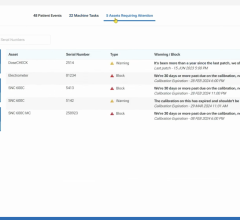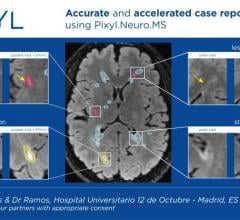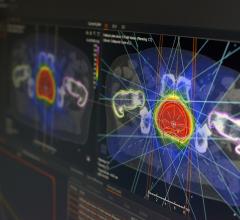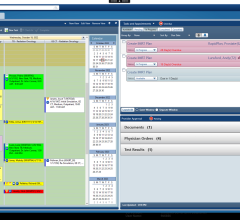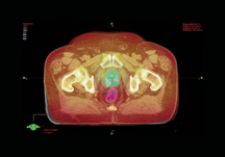
Varian Medical Systems' ARIA Oncology Information System allows access to images for treatment planning.
Radiation therapy (RT) is an imaging intensive process across multiple stages -- simulation, planning and treatment -- and is technologically intensive. To keep up with the needs of this treatment, it would seem that oncology IT, such as oncology information management systems (OIMS), would be racing to deliver new enhancements and features. And while it is, could programs like OIMS be acting as a catalyst for the innovation in RT?
If you consider the ways that OIMS, EMR and Oncology PACS are delivering patient data at the point of care, providing decision support through quantitative analysis tools and updated images, technology is enabling clinicians to improve accuracy and the overall treatment.
Anywhere Access
As clinical images move beyond department silos and across the hospital, electronic medical record (EMR) systems are providing the foundation for managing processes. Radiation oncologists are quickly recognizing the advantages of an EMR for delivering better patient outcomes, improving departmental efficiency and integrating medical and radiation oncology records.
The new generation of OIMS is integrated with EMRs to enable image and data access from anywhere. One of the pioneers of an EMR-integrated OIMS is Varian Medical Systems’ ARIA Oncology Information System, an oncology-specific electronic medical record (EMR) that combines all patient records and makes all administrative, clinical and financial information available to oncologists across the healthcare enterprise. ARIA has an image and plan management application that is DICOM RT-compliant and uses HL7 standards. “For the physicist, when ARIA is integrated with Varian’s Eclipse treatment planning, the need to import and export data between different systems is eliminated, which is important when performing QA and adapting treatment parameters during a course of therapy,” indicated Meryl Ginsberg of Varian Medical Systems. “When physicians can review and edit their patients’ charts at any point in the process, from anywhere in the clinic, they can spend more time with patients and less time with technology.”
Critical Calculations in Treatment Planning
Accuracy in patient positioning is no doubt crucial to effectively delivering treatment and one of its biggest challenges.
“We’re limited by our ability to know what to target and the imaging. Image-guided radiation therapy (IGRT) allows you to adjust so that you can be more confident and make the radiation tighter. That is the wave of the future for radiation oncology versus standard radiation – to use imaging guidance to either roughly position the patient either before or during the treatment,” said William Small, M.D., vice chairman and associate professor of Radiation Oncology at Northwestern Memorial Hospital, Chicago.
One solution that supports IGRT in correctly positioning patients prior to treatment is the MOSAIQ 1.2 by IMPAC. The system features Setup Intelligence, an image-enabled software that employs online or offline quantitative analysis tools for patient positioning. Positional shift information is calculated using MOSAIQ’s planar and 3-D image registration capabilities or can be collected from a third-party system. This information is used in support of clinical decision-making and is integrated with treatment. Being able to review, analyze, record and graph important patient shift data on a daily basis allows physicians to make treatment decisions based on a broader view of the patient’s treatment rather than on a single data point. A new extension to this image-enabled EMR system is the MOSAIQ Oncology PACS, a solution designed to manage increasingly large volumes of image data generated in radiotherapy. The system allows users to archive, retrieve and manage information to support advanced IGRT techniques.
Another critical calculation in treatment planning is staging the tumor. Siemens offers another way for treatment providers to be more efficient through its LANTIS oncology management system. According to Claudia Wasche, product marketing specialist for Siemens Medical Solutions, the new features of the LANTIS include an auto-staging feature, which calculates the stage of the tumor based on TNM values. Wasche explained, “It’s a one click process. It saves time and error.” She added, “Another feature is Careplans for Radiation Oncology. This tool allows one to create a sequence of tasks and procedures which a patient goes through as part of their treatment, (e.g., simulation, planning, treatment, blood count, portal images) — all of them can be planned throughout the course of the treatment. You can, for example, build a template for an IMRT treatment for the breast, and then apply it when needed.” In addition, LANTIS interfaces with all of Siemens' syngo radiation therapy workspaces and thereby enables the integration of treatment data and imaging. LANTIS also interfaces with other linear accelerator manufacturers as well as hospital and information systems, enabling an inter-departmental workflow. In addition, LANTIS provides a central workplace accessible to all users, including the dosimetrist, the therapist, the physicist for performing quality assurance and the oncologist for delivering the dose.
“The key is that it is the central system that everyone can access from wherever they are. And everyone can feed and read information based on their user-role and access rights,” said Wasche. “Everything that you would ever write down on paper has a place in LANTIS and allows hospitals to be virtually paperless, especially with the help of eScan – a module that allows one to scan external documents into the system and have them associated with the respective patient file and available electronically.”
Setting a New Curve
As OIMS today delivers new features to further interconnect the healthcare enterprise, users can expect to see in future versions of Varian’s OIMS “[s]upport for evolving modalities like adjuvant chemotherapy and radiotherapy treatment, proton therapy, image-guided stereotactic radiosurgery and advanced forms of intensity modulated radiotherapy will be continually enhanced,” said Ginsberg. “Another goal is to help treatment centers become completely paperless, enhancing efficiency and reducing costs.”
Across OIMS there will be expanded support for IGRT, including improved online and offline 3-D, 4-D and 5-D imaging tools and analysis, clinical rules engines to customize workflow and support decision making. Systems will be designed with a continued focus on enhanced and integrated workflow throughout the department by coordinating events in any system, such as treatment planning, imaging modalities and hospital management systems. Whether IT is catching up with developments in RT techniques or pushing them forward, it is clear that clinical procedures will continue to rely on technology to advance the overall delivery of treatment. <


 July 11, 2024
July 11, 2024 


